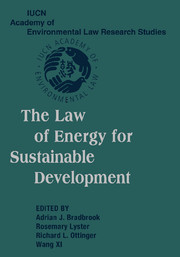Book contents
- Frontmatter
- Contents
- Acknowledgments
- Message from Kofi A. Annan, Secretary-General, United Nations
- Introduction – A Global Learned Society to Address Earth's Evolution: The IUCN Academy of Environmental Law
- Public Lectures on International Environmental Law
- PART ONE SUSTAINABLE DEVELOPMENT AND THE ROLE OF ENERGY LAW
- PART TWO LEGAL ISSUES IN CONTEMPORARY ENERGY LAW
- PART THREE INTERNATIONAL ENERGY LAW
- PART FOUR COMPARATIVE ENERGY LAW
- PART FIVE ELECTRICITY RESTRUCTURING
- PART SIX FINANCING FOR SUSTAINABLE ENERGY
- PART SEVEN CIVIL SOCIETY AND THE PROCEDURAL REQUIREMENTS OF ENERGY LAW FOR SUSTAINABLE DEVELOPMENT
- Index
- References
Public Lectures on International Environmental Law
Published online by Cambridge University Press: 10 August 2009
- Frontmatter
- Contents
- Acknowledgments
- Message from Kofi A. Annan, Secretary-General, United Nations
- Introduction – A Global Learned Society to Address Earth's Evolution: The IUCN Academy of Environmental Law
- Public Lectures on International Environmental Law
- PART ONE SUSTAINABLE DEVELOPMENT AND THE ROLE OF ENERGY LAW
- PART TWO LEGAL ISSUES IN CONTEMPORARY ENERGY LAW
- PART THREE INTERNATIONAL ENERGY LAW
- PART FOUR COMPARATIVE ENERGY LAW
- PART FIVE ELECTRICITY RESTRUCTURING
- PART SIX FINANCING FOR SUSTAINABLE ENERGY
- PART SEVEN CIVIL SOCIETY AND THE PROCEDURAL REQUIREMENTS OF ENERGY LAW FOR SUSTAINABLE DEVELOPMENT
- Index
- References
Summary
LECTURE 1: INTRODUCTION – THREE QUESTIONS
Allow me to tell you how much I appreciate and admire the organization of the present conference, the contribution of the Shanghai Jiao Tong University and the huge preparatory work done by Professor Wang Xi and his outstanding team. I am very grateful for having been invited.
It is a great honor for me to deliver the First Academy Public International Lecture of Environmental Law. While I am very proud of this distinction, I am even more pleased that IUCN and its Commission of Environmental Law were able to create that Academy. I know the considerable difficulties that the initiative of that creation had to overcome and the immense talent and energy which the President of that Commission, Professor Nicholas Robinson, invested in this enterprise.
The present conference concerns international environmental law. I propose to you to examine separately the three terms that figure in this phrase: “international,” “environmental,” and “law.” I will, however, modify this order and start with “environment” and then discuss successively “law” and “international.”
WHY DO WE SPEAK OF THE ENVIRONMENT?
The term “environment” can describe a limited area, the entire planet, or even include a part of the outer space that surrounds the Earth. The term “biosphere,” used in particular by the United Nations Educational, Scientific, and Cultural Organization (UNESCO), is more precise, if still broad. It designates the totality of the human environment, the part of the universe where, according to present knowledge, all life is concentrated.
- Type
- Chapter
- Information
- The Law of Energy for Sustainable Development , pp. 6 - 34Publisher: Cambridge University PressPrint publication year: 2005



